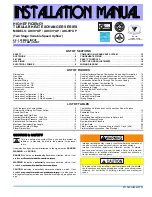
8
FURNACE & AIR DUCTS
• The furnace should be inspected annually by a licensed
HVAC technician. Table 1 (page 9) contains suggested
inspections and frequency of maintenance.
• Homeowners should perform frequent visual inspections of
the furnace for obvious signs of deterioration. The furnace
should be secure without sagging, cracks gaps, etc around
the base. The return air duct connection(s) is secured
and sealed to the furnace cabinet and terminates outside
the area containing the furnace. Any signs of damage or
loose connections should be repaired by a qualified HVAC
technician.
VENTING SYSTEM
• For proper and safe operation, this furnace requires
unrestricted airflow for combustion and ventilation. Inspect
for blocked or obstructed air openings on or around the
furnace (at the terminations outside the house), and the
space around the furnace.
• The furnace venting system should be inspected annually by
a licensed HVAC technician. Vent pipe must slope upwards
and be physically secured without holes or corrosion. Any
corroded section of vent pipe must be replaced, and any
obstruction or blockage must be removed by the technician.
• Flue passageways, the vent system, and the burners should
be inspected and cleaned (if required) by a licensed HVAC
technician annually to ensure continued safe operation.
• Existing masonry chimneys should be inspected and relined
(if necessary) by a licensed HVAC technician.
BLOWER & FILTER
• It is recommended that the blower compartment be cleaned
of dirt or lint that may have accumulated in the compartment
or on the blower and motor as part of the annual inspection.
• Keep air filters cleaned. It is recommended that the furnace
air filter be checked at least once a month. Clean or replace
filter to maintain proper airflow and achieve maximum
efficiency.
• Furniture and drapery should be arranged so that the
supply air registers and return grilles are not obstructed.
BURNER OPERATION
Perform the startup instructions on page 7. The igniter should
ignite the closest burner and the flames should quickly
carryover to the other burners. The flames should be bright
blue, with occasional yellow streaks.
NEW CONSTRUCTION
Operating gas furnaces in construction environments can
cause a variety of problems within the furnace and may
significantly reduce the life or the performance of the furnace.
Therefore operating the furnace during construction is not
permitted and will void the warranty.
• Before occupancy, the furnace shall be inspected and
approved by applicable local authority even if this results
in redundant inspections.
• The duct work must be inspected and cleaned if found to
contain any construction debris.
• The filter must be replaced or cleaned and the furnace
must be inspected by a licensed HVAC technician. The
furnace must be cleaned and/or repaired if found to be
dirty, damaged, or malfunctioning in any way.
MAINTENANCE & INSPECTION
IF THE FURNACE FAILS TO OPERATE CHECK THE
FOLLOWING:
1. Is the thermostat setting correct?
2. Are the blower compartment door(s) in place?
3. Has the circuit breaker tripped or the control board fuse
burned open?
4. Is the gas turned on at the manual shutoff?
5. Is the filter dirty or clogged?
If the furnace still doesn’t operate, contact a licensed HVAC
technician
TROUBLESHOOTING






























